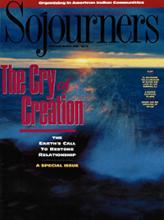Every year Sojourners Community makes a retreat in the Maryland countryside. Down the hill from the retreat center, over a muddy lane, past the cow pasture and the barn, is a slave cemetery. The small, anonymous plot is overgrown with weeds and surrounded by a crumbling wall.
Many of us make a trip at least once to the cemetery during our annual retreat -- some at sunrise, others at sunset, or in the dark of night with an expanse of stars overhead. It is a still and quiet place -- last year lightly dusted with snow -- where if you listen closely you can almost hear the spirituals that gave hope to the people buried there. That crumbling wall marks holy ground.
I think of that wall as we enter Lent, remembering the rich imagery of our path through Lent last year. Rose Berger, who brings a fertile poetic spirit to our Sojourners worship, led us on Lent's journey of reconciliation, back home to our "native land." We literally picked up rocks and began walking, with the rocks as signposts along the way and reminders of the redemption that awaited us at Easter.
WE BEGAN ON ASH WEDNESDAY with rocks hauled from Washington, D.C.'s Rock Creek Park by Jim Tamialis, one of our pastors. A whole pile of them stood before us -- one for each of us.
The Ash Wednesday gospel reading was the opening of the eighth chapter of John, the story of the woman caught in adultery. The scribes and Pharisees reminded Jesus that, the law of Moses demanded that they stone her to death. Jesus' response was to bend down and write with his finger on the ground -- some believe he was listing the others' sins. When the scribes and Pharisees persisted with their questioning, Jesus said simply, "Let the one who is without sin among you be the first to throw a stone at her." And they went away, one by one.
Read the Full Article
